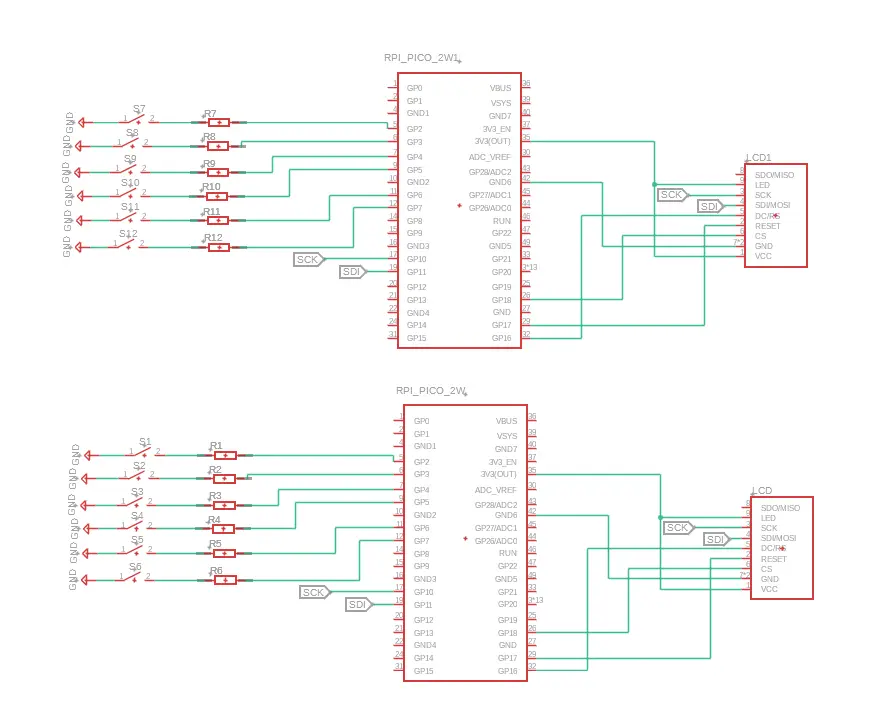Pico-checkers
A game in rust that resembles the classic Checkers Game.
Author: Preda Victor-Andrei
GitHub Project Link: link_to_github
Project Description
This project resembles the traditional game of checkers, implemented as an online multiplayer experience. Players can move their pieces freely in all four diagonal directions (up-right, up-left, down-right, down-left) from the very first turn, adding strategic depth to every match.
- 6-button control system per player:
- 4 directional buttons for movement
- 2 selection buttons to highlight valid pieces
- Dedicated LCD displays showing the real-time game board
- Online multiplayer support for competitive play
Motivation
As a fan of old-school strategy games, I’ve always loved the elegance of checkers—its simple rules hiding deep tactical possibilities. This project merges nostalgic gameplay with modern technology, which motivated my development approach.
Architecture

-
Raspberry Pi Pico 2W (x2)
- Interconnected with all components
-
Buttons (x6 per player)
- Connected to each Pico, acting as input (move piece/selection)
-
2.2" 240x320 px SPI LCD (x1 per player)
- Connected through embedded-graphics at the microcontroller
-
Wi-Fi
- Microcontrollers communicate with each other through it
- Player 0 acts as the server; Player 1 acts as a client
-
Embedded-Graphics
- Library that a microcontroller is using in order to display the game
- Connects the microcontroller with the LCD
Log
Week 5 - 11 May
- Upload first state of documentation
Hardware
-
Raspberry Pi Pico 2W (x2)
- Acts as the main controller for each player's unit
- Connects all components and handles Wi-Fi communication
-
Buttons (x6 per player)
- Connected to GPIO pins:
- GP2
- GP3
- GP4
- GP5
- GP6
- GP7
- Connected to GPIO pins:
-
2.2" 240x320 px SPI LCD (x1 per player)
- Connections:
- VCC → 3.3V
- GND → GND
- CS → GP18
- RESET → GP17
- DC/RS → GP16
- SDI/MOSI → GP11
- SCK → GP10
- LED → 3.3V
- SDO/MISO → N/C
- Display table and pieces for each player
- Connections:
-
Resistors (22kΩ, x6 per player)
- Connected between buttons and GPIO pins to ensure clean digital input signals
Schematics

Bill of materials
| Product | Quantity | Unit Price |
|---|---|---|
| Raspberry Pi Pico W | 2 | 39.66 RON |
| LCD SPI 2.2" 240x320px | 2 | 59.99 RON |
| 40-pin Header (2.54mm) | 2 | 0.99 RON |
| Breadboard Jumper Wire Set | 1 | 7.99 RON |
| Large Breadboard (830 points) | 2 | 9.98 RON |
| Male-to-Female Jumper Wires (40p) | 1 | 7.99 RON |
| Male-to-Male Jumper Wires (40p) | 1 | 7.99 RON |
| Round Tactile Buttons | 12 | 1.99 RON |
| Resistors 22kΩ | 12 | 0.2 RON |
Software
| Library | Description | Usage in Project |
|---|---|---|
embedded-graphics | 2D drawing framework for embedded systems | Renders checkers board, pieces, and UI on LCD displays |
rp2040-hal | Raspberry Pi Pico hardware support | Manages GPIO buttons (GP2-GP7) and SPI LCD control |
embassy | Async embedded runtime | Handles Wi-Fi multiplayer synchronization |
embedded-hal | Hardware abstraction layer | Standardizes hardware interactions |
embedded-time | Timing utilities | Controls game loop and move timing |